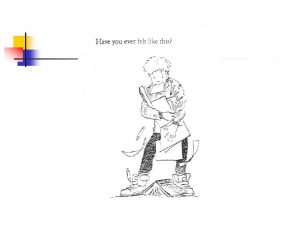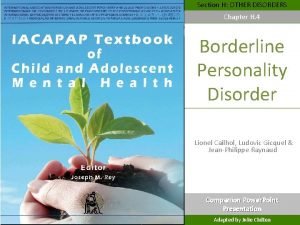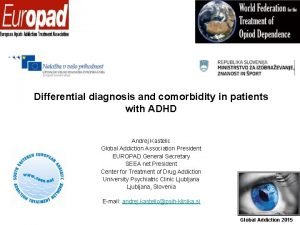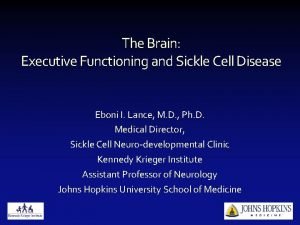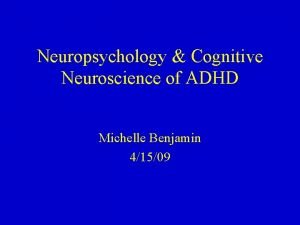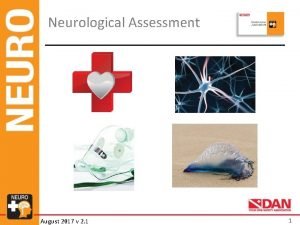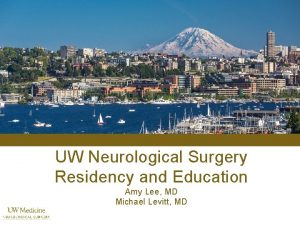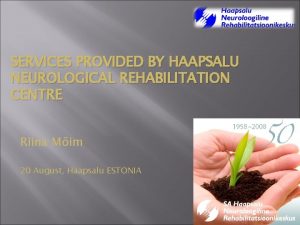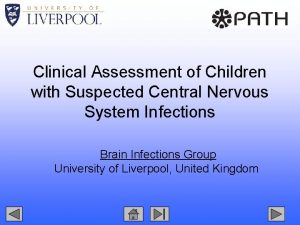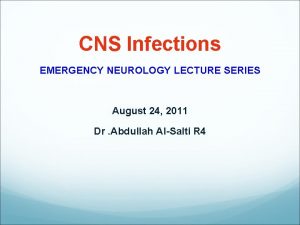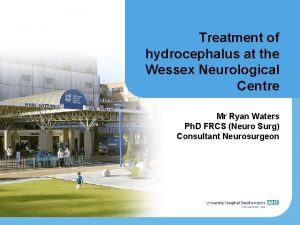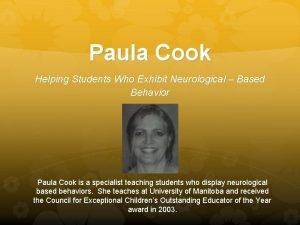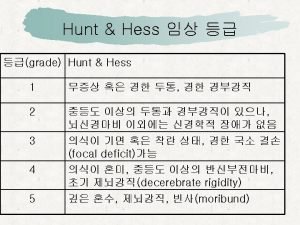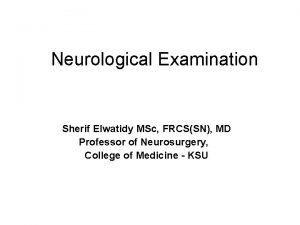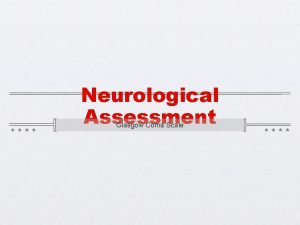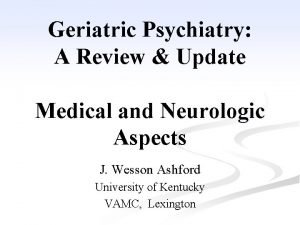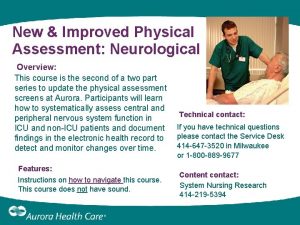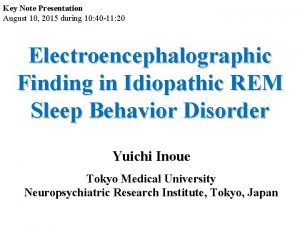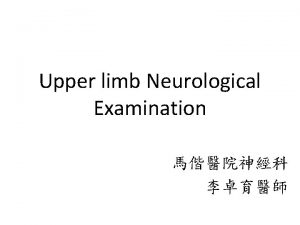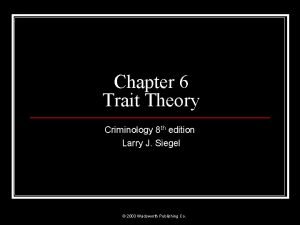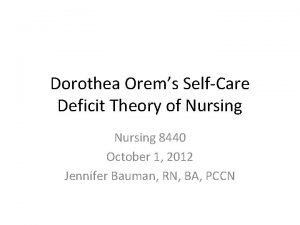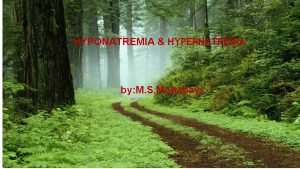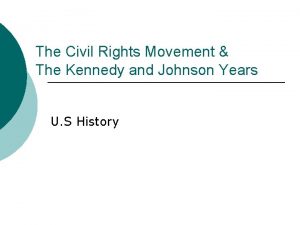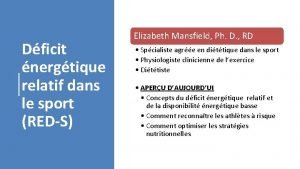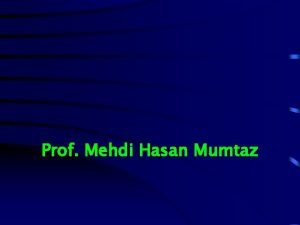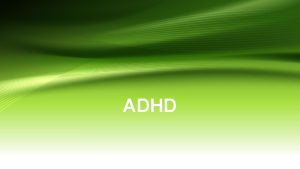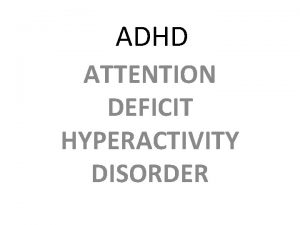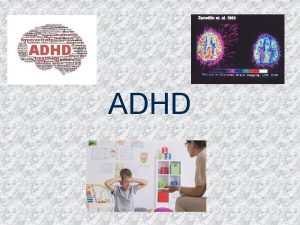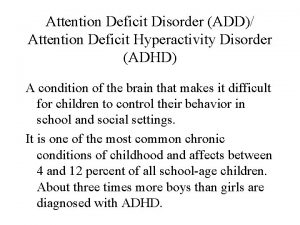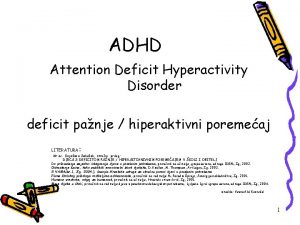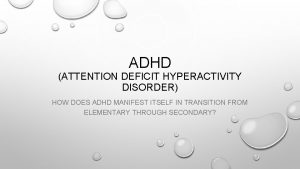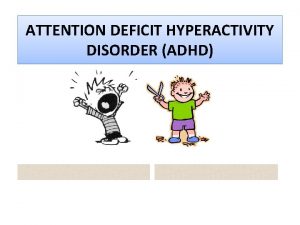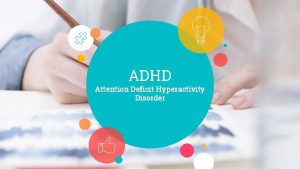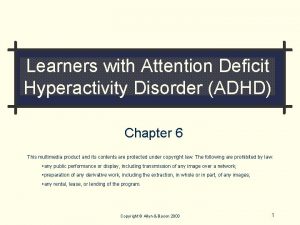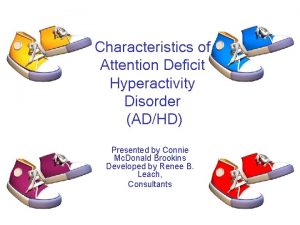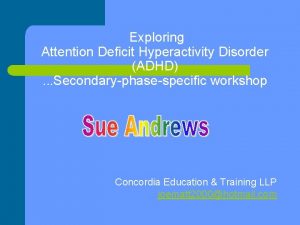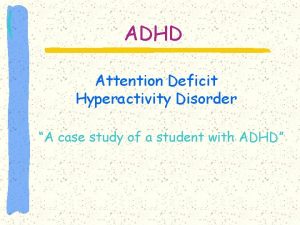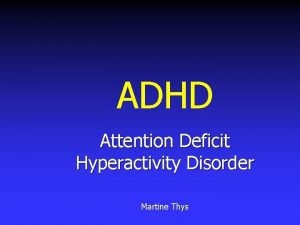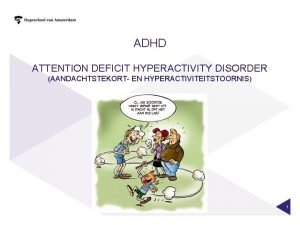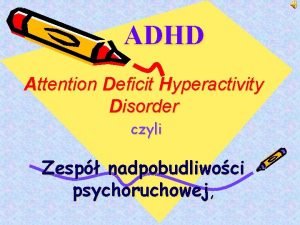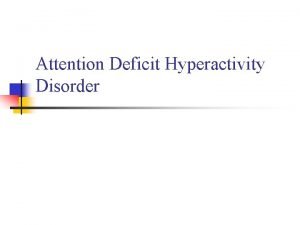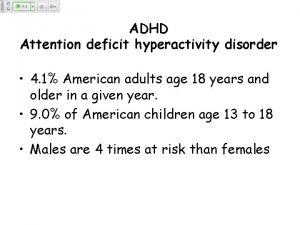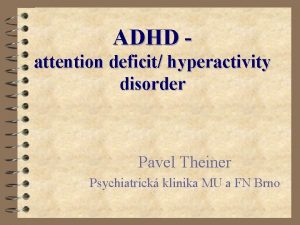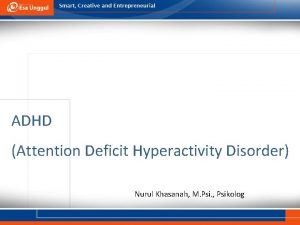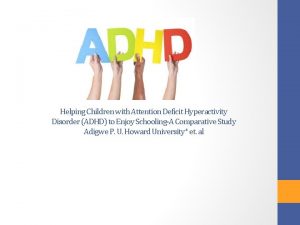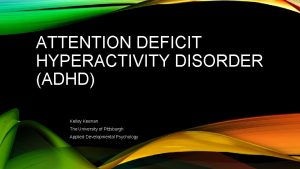Attention deficit hyperactivity disorder ADHD is a neurological
































- Slides: 32


Attention deficit hyperactivity disorder (ADHD) is: a neurological condition that involves problems with inattention and hyperactivity-impulsivity that are developmentally inconsistent with the age of the child. Three Sub Types Predominantly inattentive Predominantly hyperactive - impulsive Combined

DSM V Criteria (http: //www. adhd-institute. com/assessment-diagnosis/dsm-5 tm/ ) n A persistent pattern of inattention and/or hyperactivityimpulsivity that interferes with functioning or development n Six or more of the symptoms have persisted for at least six months to a degree that is inconsistent with developmental level and that negatively impacts directly on social and academic/occupational activities. Please note: The symptoms are not solely a manifestation of oppositional behaviour, defiance, hostility, or failure to understand tasks or instructions. For older adolescents and adults (age 17 and older), five or more symptoms are required n Several inattentive or hyperactive-impulsive symptoms were present prior to age 12 years

DSM V Criteria (continued) (http: //www. adhd-institute. com/assessment-diagnosis/dsm-5 tm/) n n Several inattentive or hyperactive-impulsive symptoms are present in two or more settings (e. g. at home, school, or work; with friends or relatives; in other activities) There is clear evidence that the symptoms interfere with, or reduce the quality of, social, academic or occupational functioning n The symptoms do not occur exclusively during the course of schizophrenia or another psychotic disorder and are not better explained by another mental disorder (e. g. mood disorder, anxiety disorder, dissociative disorder, personality disorder, substance intoxication or withdrawal)

GENERAL INFORMATION n n n FIRST NOTICED BY MEDICAL SCIENCE IN 1902 ALL SOCIOECONOMIC, CULTURAL, AND RACIAL BACKGROUNDS EFFECTED 80% SHOW NO SYMPTOMS IN DR. OFFICE MOST ABOVE OR AVERAGE INTELLIGENCE VERY INCONSISTENT IN PERFORMANCE AND BEHAVIOR

PREVALENCE (CDC Statistics) n n Percent of Youth 4 -17 Ever Diagnosed with Attention-Deficit/Hyperactivity Disorder by State: National Survey of Children's Health Boys 3 x more likely to be diagnosed with ADHD.

GENERAL INFORMATION n n n n MORE OFTEN IN BOYS THOUGH GIRLS OFTEN UNDER-IDENTIFIED COMMON WITH OTHER DISORDERS ABOUT 50% HAVE MOTOR PROBLEMS 1/3 TO 1/2 HAVE BLADDER CONTROL PROBLEMS 40% CHILDREN WITH LD ALSO HAVE ADHD 20 -25% WITH ADHD ALSO HAVE LD MOST HAVE SYMPTOMS AS ADULTS

Co morbidity 65% of children with ADHD will have a co morbid condition 60% of those with Tourette’s Syndrome have ADHD 20 -30% will also suffer depression 50 % of youth with Bipolar Disorder have ADHD 50% Of those with Tourette’s Syndrome have Obsessive Compulsive Disorder

Other Co morbid Difficulties Conduct Disorders Anxiety Disorders Drug Abuse Obsessive Compulsive Disorder Tourette’s Syndrome Sleep Disorders Oppositional Defiant Disorder Learning Disabilities

Additional Statistics n n 30% never finish high school 43% of untreated ADHD aggressive boys are arrested n 75% of those in prison have ADHD n 75% will have interpersonal problems n 2 - 4% of adult population have ADHD n Medically untreated ADHD leads to an increase in substance abuse as adults

Research findings n Biological factors – n n Brain imaging research has shown differences exist in brains of children with and without ADHD Genetic influences – n Family History n Identical Twin Studies

NEUROBIOLOGICAL DISABILITY n IMBALANCE OF CERTAIN CHEMICALS IN THE BRAIN: n n n DOPAMINE NOREPINEPHRINE SEROTONIN DECREASED ACTIVITY IN CERTAIN AREAS OF THE BRAIN CHRONIC – USUALLY LIFE LONG



Research does not support… that these factors lead to ADHD: n n n Food additives Sugar Yeast Poor child rearing methods Excessive television viewing

A comprehensive evaluation Behavioral Component includes Educational Component Medical Component

Behavioral evaluation n Specific questionnaires and rating scales are used to distinguish between children with and without ADHD and quantify behavioral characteristics Completed by different sources such as teachers and parents Observations of the child done in various settings by a teacher, nurse, social worker, or psychologist as well as rating scales can assist in diagnosing a child

Medical Evaluation n Assesses whether a child is manifesting symptoms of ADHD regarding: n Inattention n Impulsivity n Hyperactivity Assesses the severity of these problems Gathers information about other disabilities that may be contributing to the child’s ADHD symptoms

Educational evaluation n n Assesses the extent to which the symptoms of ADHD impact on the academic performance in school Includes: n n direct observations of the child review of academic productivity n n assessment of completion of class work and homework both percentage of work completed and accuracy of the work are considered

Treatment Options Pharmacological Approach include Behavioral Approach Multimodal Approach

Pharmacological approach n Medical profession prescribes meds – school staff need to monitor n 80% of students respond to treatment with stimulant meds n May need to try various meds for best results n All meds have side effects n n n Not everyone experiences side effects Often are temporary and subside after few weeks of treatment Need to be reported to parents and doctors

Medications begin to work n Antidepressants 4 – 6 weeks n Stimulants 30 – 60 minutes n Neuroleptics 2 – 4 weeks may have some earlier effect on certain symptoms such as aggression or sleep n Mood stabilizers/anti- 3 – 6 weeks or longer seizure medications depending on dose (need to obtain therapeutic blood level)

Multimodal approach n Multimodal treatment is a combined approach that includes the use of n n n Medication Educational Interventions Behavioral Management Training and Counseling for both parents and children Results of NIMH Multimodal Treatment Study n n n Compared four interventions – medication, behavioral intervention, combination of medication and behavioral intervention, and nointerventioo community care Found that combined medication/behavior intervention and medication treatment were significantly better than behavioral therapy alone or community care alone in reducing the symptoms of ADHD. Found lower medication dosage is effective in multimodal treatment

Untreated ADHD - Impact on School Performance Core Features Effects Inattention Hyperactivity n missing assignment details n miss information during lectures n assignment organization difficulty verbal disruptions n physical disruptions n Impulsivity n hurriedly respond to questions n make careless errors Studies have found: n lower average marks n more failed grades n more expulsions and suspensions n increased dropout rates n lower rate of college undergraduate completion

ANTIDEPRESSANTS Examples: n n n n Citalopram (Celexa) Escitalopram (Lexapro) Fluoxetine (Prozac) Mirtazapine (Remeron) Imiprimine (Tofranil) Bupropion (Wellbutrin) Sertraline (Zoloft) Paroxetine (Paxil) and Venlafaxine (Effexor) are rarely used in children due to recent FDA warnings) Side Effects: n n n Dry mouth Nausea Vomiting Headache Excessive sweating Weight gain/loss Tremor Constipation Dizziness Sedation Nervousness Diarrhea

STIMULANTS Examples: n n Amphetamine/ Dextroamphetamine- (Adderall) Methylphenidate hydrochloride (Ritalin, Concerta-(long-acting) Dexmethylphenidate (Focalin) Metadate Side Effects: n n n Headache Decreased appetite Weight loss Sleeplessness/insomnia Motor tics Palpitations

NON-STIMULANTS n n Don’t cause agitation or sleeplessness n Are not controlled substances and don’t pose the same risk of abuse or addiction Have a longer-lasting and smoother effect than many stimulants, which can take effect and wear off abruptly Atomoxetine HCl (Stratterra) Side effects n n n Upset stomach Decreased appetite, which may cause weight loss Nausea Dizziness Fatigue Mood swings

Mood stabilizers/anti-seizure Side Effects: Examples: n n n Divalproex Sodium (Depakote)* Lithium (Eskalith)* Carbamazepine (Tegretol)* Topiramate (Topomax) Oxcarbazepine (Trileptal) n n n n n * Need blood level monitoring n n n Nausea Vomiting Hair loss Weight gain Tremor Constipation Diarrhea Headache Sedation Acne Rash Bruising Sleep problems Blurred vision Ringing in ears

Neuroleptics (previously called anti-psychotics) Examples: helping to restore the balance of certain natural substances in the brain (neurotransmitters). n n Aripiprazole (Abilify) Risperidone (Risperdal) Quetiapine (Seroquel) Olanzapine (Zyprexa) Side Effects: n n n n n Dry mouth Headache Weight gain Constipation Sedation Anxiety Agitation Rapid heartbeat Urination problems Very low blood pressure

ANTI-hypertensives Examples: n Clonidine (Catapres) may be most n beneficial in children with ADHD, who are easily emotionally overwhelmed, are anxious, and have a low frustration tolerance Guanfacine (Tenex or Intuniv) n given. 5 mg BID. regulates levels of the neurotransmitter norepinephrine; in the prefrontal cortex of the brain, it decreases sensitivity to distracting stimuli, and it therefore may help with focus Side Effects: n n n Anxiety Constipation Dizziness Drowsiness Dry eyes/mouth Fatigue Headache Decreased appetite Nausea Nervousness Rash

ANTI-anxiety Examples: n n n Lorazepam (Ativan) Clonazepam (Klonopin) Diazepam (Valium) Alprazolam (Xanax) Usually doctors (child/adolescent psychiatrists) will use anti-depressants to treat anxiety in children as there is an increased risk of addiction and abuse in using anti-anxiety medications (benzodiazepines).

We really have a lot more in common with some of these people than we think!
 Is adhd a neurological disorder
Is adhd a neurological disorder Adhd and borderline personality disorder
Adhd and borderline personality disorder Adhd or bpd
Adhd or bpd Autism spectrum disorder adhd
Autism spectrum disorder adhd Malingering
Malingering Alternating attention vs divided attention
Alternating attention vs divided attention Motor function neurological assessment
Motor function neurological assessment Uw neurological surgery
Uw neurological surgery Physio rehab centre
Physio rehab centre Muscle power neurological examination
Muscle power neurological examination Snowdon neurological rehabilitation unit
Snowdon neurological rehabilitation unit What is focal neurological signs
What is focal neurological signs Normal pressure hydrocephalus triad
Normal pressure hydrocephalus triad Neurological based behavior
Neurological based behavior Ao classification system
Ao classification system Grade wfns
Grade wfns Fudoscopy
Fudoscopy Abnormal flexion vs extension
Abnormal flexion vs extension Neurological observations glasgow coma scale
Neurological observations glasgow coma scale Compare and contrast first and second language acquisition
Compare and contrast first and second language acquisition Neurological examination
Neurological examination Pupil size chart
Pupil size chart Neurological disease
Neurological disease Muscle power neurological examination
Muscle power neurological examination What is trait theory in criminology
What is trait theory in criminology Budžetski deficit
Budžetski deficit Dorothea e orem
Dorothea e orem Hyponatremia correction formula pdf
Hyponatremia correction formula pdf Metodo de deficit acumulado
Metodo de deficit acumulado Deficit spending
Deficit spending Tigran becker
Tigran becker Déficit énergétique relatif dans le sport
Déficit énergétique relatif dans le sport Base deficit formula
Base deficit formula
